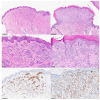Kinase Fusions in Spitz Melanocytic Tumors: The Past, the Present, and the Future
- PMID: 38390852
- PMCID: PMC10885070
- DOI: 10.3390/dermatopathology11010010
Kinase Fusions in Spitz Melanocytic Tumors: The Past, the Present, and the Future
Abstract
In recent years, particular interest has developed in molecular biology applied to the field of dermatopathology, with a focus on nevi of the Spitz spectrum. From 2014 onwards, an increasing number of papers have been published to classify, stratify, and correctly frame molecular alterations, including kinase fusions. In this paper, we try to synthesize the knowledge gained in this area so far. In December 2023, we searched Medline and Scopus for case reports and case series, narrative and systematic reviews, meta-analyses, observational studies-either longitudinal or historical, case series, and case reports published in English in the last 15 years using the keywords spitzoid neoplasms, kinase fusions, ALK, ROS1, NTRK (1-2-3), MET, RET, MAP3K8, and RAF1. ALK-rearranged Spitz tumors and ROS-1-rearranged tumors are among the most studied and characterized entities in the literature, in an attempt (although not always successful) to correlate histopathological features with the probable molecular driver alteration. NTRK-, RET-, and MET-rearranged Spitz tumors present another studied and characterized entity, with several rearrangements described but as of yet incomplete information about their prognostic significance. Furthermore, although rarer, rearrangements of serine-threonine kinases such as BRAF, RAF1, and MAP3K8 have also been described, but more cases with more detailed information about possible histopathological alterations, mechanisms of etiopathogenesis, and also prognosis are needed. The knowledge of molecular drivers is of great interest in the field of melanocytic diagnostics, and it is important to consider that in addition to immunohistochemistry, molecular techniques such as FISH, PCR, and/or NGS are essential to confirm and classify the different patterns of mutation. Future studies with large case series and molecular sequencing techniques are needed to allow for a more complete and comprehensive understanding of the role of fusion kinases in the spitzoid tumor family.
Keywords: ALK; MAP3K8; MET; NTRK; RET; ROS1; Spitz spectrum; gene fusions; kinase fusions; melanocytic proliferations.
Conflict of interest statement
The authors declare no conflicts of interest.
Figures

Similar articles
-
An Update on Molecular Genetic Aberrations in Spitz Melanocytic Proliferations: Correlation with Morphological Features and Biological Behavior.Acta Med Acad. 2021 Apr;50(1):157-174. doi: 10.5644/ama2006-124.333. Acta Med Acad. 2021. PMID: 34075771
-
The role of gene fusions in melanocytic neoplasms.J Cutan Pathol. 2019 Nov;46(11):878-887. doi: 10.1111/cup.13521. Epub 2019 Jun 20. J Cutan Pathol. 2019. PMID: 31152596 Review.
-
Morphologic features in a series of 352 Spitz melanocytic proliferations help predict their oncogenic drivers.Virchows Arch. 2022 Feb;480(2):369-382. doi: 10.1007/s00428-021-03227-x. Epub 2021 Nov 11. Virchows Arch. 2022. PMID: 34761304
-
Spitz Tumors With ROS1 Fusions: A Clinicopathological Study of 6 Cases, Including FISH for Chromosomal Copy Number Alterations and Mutation Analysis Using Next-Generation Sequencing.Am J Dermatopathol. 2020 Feb;42(2):92-102. doi: 10.1097/DAD.0000000000001499. Am J Dermatopathol. 2020. PMID: 31361613
-
Genomic aberrations in spitzoid melanocytic tumours and their implications for diagnosis, prognosis and therapy.Pathology. 2016 Feb;48(2):113-31. doi: 10.1016/j.pathol.2015.12.007. Epub 2016 Jan 18. Pathology. 2016. PMID: 27020384 Free PMC article. Review.
Cited by
-
NTRK1-rearranged histiocytosis: clinicopathologic and molecular features.Blood Adv. 2025 Jul 22;9(14):3617-3628. doi: 10.1182/bloodadvances.2025016167. Blood Adv. 2025. PMID: 40315374 Free PMC article.
-
A Retrospective Analysis of Ambiguous Spitz Tumors Using Next-Generation Sequencing.Cancers (Basel). 2025 Apr 4;17(7):1227. doi: 10.3390/cancers17071227. Cancers (Basel). 2025. PMID: 40227833 Free PMC article.
References
-
- WHO Classification of Tumours Editorial Board . Skin Tumours. 5th ed. Volume 12. International Agency for Research on Cancer; Lyon, France: 2023. [(accessed on 26 December 2023)]. (WHO Classification of Tumours Series). Available online: https://tumourclassification.iarc.who.int/chapters/64.
Publication types
LinkOut - more resources
Full Text Sources
Research Materials
Miscellaneous

